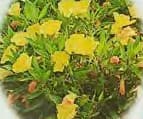How to Grow and Care for Primrose Flowers

About Growing Primrose Plants in Your Home Flower Garden
Perennial Primrose plants are a hardy flower, that includes a wide range of varieties. The plants are native to Asia, Europe, and North America. In North America, they originally were found in the Midwest to the Northwest areas of the U.S. This woodland plant brightens up areas of your yard where other flowering plants refuse to grow. Primrose flowers come in a wide variety of colors, in single blooms or in clusters. Flowers are sweet-smelling. Flowers bloom throughout the summer season. When growing primrose from seed for the first time, you need to have patience. Plan on new plants blooming in the second year. Garden stores sell young plants already in bloom.
There are many kinds of Primrose. From a gardener’s viewpoint, they can be put into two groups: those that grow in bogs and woodlands, and those that thrive in rocky areas and on cliffs or hillsides. And, some varieties prefer rich, wet soils. While others like their soil dry. Therefore, it is important to know the variety of Primrose so you can identify its growing habitat before you plant them.
There’s another reason to grow this pretty, sweet-smelling flower. Primrose flowers attract Hummingbirds, too.
The plants are excellent for hillsides and as ground covers. Use it on steeper slopes where it is difficult to grow grass and cut it. Shorter varieties grow well in flowerpots and containers on your patio or deck. They are a great choice in partially shaded balconies, too.
Primrose Flowers Plant Specifications
Flower Colors: Colors include blue, orange, pink, purple, red, white, and yellow.
Flowers Bloom: Summer to early Fall.
Plant Height: Eighteen to twenty four inches tall.
Ideal Soil pH: 6.0 – 7.5.
Hardiness Zones: 2 – 8
Light Requirements: Partial sunlight to light shade.
Is the Plant Toxic? No.
Deer Resistant? Yes. The strong scent and bitter taste of the leaves and flowers make this plant resistant to deer, rabbits, and other foraging animals.
Native To: Asia, Europe, and North America.
Number of Species: The entire Primrose family of plants has an astounding 2,600 species. species.
Plant Type: Perennial.
Botanical Name: Primula
Other Names: Polyanthus
Are Primrose Plants Edible?
YES!!
The young leaves and flowers are edible raw or cooked. Young leaves have a mild and sweet taste. Older leaves turn bitter. The flowers have a subtle, floral flavor. Also, the roots are edible. Use the roots raw, cooked, or boiled.
Medicinal Applications for Primrose Plants
Primrose plants have several medicinal uses. Here are some of them:
- Make an ointment to treat wounds and other skin problems. Boil the flowers in lard. Then, apply it to burns, wounds, and other skin ailments.
- It can eliminate wrinkles.
- Use it to heal pimples.
- It is a component in homemade eyewashes.
Light Requirements
When it comes to light requirements, Primrose plants are “Tweeners”. They thrive best in the partial sunlight areas of your yard that are between full sunlight and full shade.
The best location for them is where they receive morning sunlight and are shaded from the hot afternoon sun. Also, some varieties grow best in full shade. So, check the growing instructions on the label when you buy the plants.
Primrose Plant Propagation
Perennial Primrose is grown from seed. Primrose plants do not transplant well. It is best to directly seed them into your flower garden, a hillside, or anywhere that you want to use them as ground cover.
Sow Primrose seeds early in the season and cover lightly with soil. Seed spacing varies by variety. Check the instructions on the seed packet.
Final plant spacing: If information is not available, use 12″ to 15″ spacing as a gauge.
Day to Germination: 10 – 15

How to Grow Primrose Flower Plants
Perennial Primrose plants are easy to grow. They prefer cool weather, and partial sun to shade depending upon variety.
Soil conditions vary from rich loam to average soils, depending upon the variety. Mix in plenty of leaf mold or compost before planting. Add leaf mold, if available, each year as a mulch. It also fertilizes the plants as it decomposes. The leaf mulch also helps to retain soil moisture and gives the area a neat and tidy appearance.
Water the plants as needed during hot and dry weather. Drought-tolerant varieties are very popular as ground cover in dry areas.
It is important to know the primrose variety that you are growing. Some varieties grow in bogs and woodlands, and others thrive in rocky areas and on cliffs or hillsides. Also, some varieties of primrose prefer rich, wet soils. But, others like their soil dry.
Once your Primrose plants are established, they will grow well and bloom all summer long with little or no attention. Anticipate the first blooms in the second year. Being very hardy, they will likely survive the first light frosts before going dormant for the winter. They do not require mulching or protection in the winter.
Deadheading the spent blooms encourages the development of new flower buds. Use a sharp pruning shear to remove the stem of the dead flower where it meets the stem of the plant.
More on Deadheading flowers to promote new blooms.
How to Grow Primrose Plants in Flowerpots and Containers
Perennial Primrose flowers are good candidates to grow in containers and flowerpots. We recommend using shorter varieties. Their bright, cheery blooms will brighten up any shaded or partly shaded balcony, patio, or deck.
In addition to the normal steps for growing them, here’s how to care for them in a flowerpot or container:
- It is important to have a drain hole to allow excess water to drain from the pot.
- Keep an eye on the moisture level. Check the plants every day or two, especially in extended periods of hot, dry weather.
- Keep the soil moist, but not wet. It is okay to let the top of the soil begin to dry between watering.
- When watering the plants, thoroughly wet the soil. Excess water will drain through the hole in the bottom of the flowerpot.
- Nutrients in a flowerpot are limited. So, use fertilizer spikes to feed the plants. Or, apply a light solution of liquid fertilizer once a month.
- Select a partly sunny to shady location on your deck or patio.
Pruning Primrose Plants
Primrose plants require little if any pruning. Remove any dead or broken stems and leaves. Prune off any diseased stems as soon as you spot them.
Deadheading spent blooms, when practical, will help to promote more blooms.
If you want to harvest some of the seeds, leave a few spent blooms on a couple of the plants.
More on Deadheading Spent Flower Blooms.
Insects and Plant Disease
Primrose plants are seldom bothered by insects and diseases. Spider mites are an occasional pest.
Fungal bacterial diseases can occur in warm and humid weather. Poor air circulation around the plant encourages these plant diseases. So, allow enough space between plants. And, thin the plants out a little, if needed.
If insect or disease problems occur, treat early with organic or chemical insect repellents and fungicides.
Also see: Plant Problems – Identify the causes and find the cures.
Overwintering Perennial Primrose Flowers
In most areas of the country, perennial Primrose plants overwinter with few, if any, problems. However, if left outdoors in cold northern climates, the roots can freeze. This will damage or kill them. So, plan on sheltering the containers from the most brutal winters.
Overwintering Primrose Plants Outdoors
Cut the plant back to about halfway to the soil level. Then, apply a thick layer of mulch over the root area. In the early spring, rake off the excess mulch.
For Overwintering Primrose Plants in Containers
First, cut the plant back about halfway to the soil level. Then, bring the container into a cool garage or shed. Bring the containers back onto your patio or deck in mid-spring.
Related Articles
Also, people who read this article on perennial Primrose flowers will like:
Please support our site. Shop for:
- rmmatthews100@hotmail.com
- 585-721-6528
- Rochester, NY
©1999-2024 GardenersNet.Com, All Rights Reserved

